What's in the box this week~~~~~~~~~~~~~~~~~~~~~~~~~~~~~~~~~~~~~~~~~~~~~~~~
Content differences between Family and
Small shares are in red; items with a
"+" in one size share are more in quantity than in the other. For any items
not from our farm, we will identify the source in parentheses. Occasionally content will differ
from this list (typically we make a substitution), but we do our best to
give you an accurate projection.
Family Share
Arugula
Broccoli (Lakeside)
Carrots
Chard
Escarole + (Frisee or broadleaf)
Fava beans
Red Russian kale
Leeks
Meyer lemons (from LEF or Marsalisi Farm)
"Little Gem" romaine lettuce (2 - 3 heads)
Mei qing choi
Young onions
Red radishes
Spinach +
Tatsoi
1 basket Strawberries
Small Share
Arugula
Broccoli (Lakeside)
Carrots
Chard
Escarole
(Frisee or broadleaf)
Fava beans
Leeks
Meyer lemons (from LEF or Marsalisi Farm)
Lettuce (bagged baby lettuce mix)
Mei qing choi
Young onions
Spinach
Tatsoi
1 basket Strawberries
Bread Option
This week's bread will be whole wheat with flax seeds
Extra Fruit
4 baskets of Strawberries!!
Fruit Bounty is 'on' this week! (so, floating week #1 of 15)
4 baskets of Strawberries!!
|
Roses: Year-Round Beauty, Sweetness and Health
~~~~~~~~~~~~~~~~~~~~~~~~~~~~~~~~~~~~~~~~~~~~~~~~ April showers did bring May flowers - especially roses - just in time for Mothers Day. The roses in our garden are in full bloom, and my son David only had to walk out the front-door to cut and arrange them into vases around the house to make his mother very happy. When Roses start blooming they become the center of attention in the garden. The same is true for all the rose family members, botanically known as the Rosaceae, growing in our fields. Most of the fruit we enjoy from the farm - the strawberries, raspberries, blackberries, apples, pears, apricots, and plums - all belong to the same Rose family. There isn't a season, a month, even a week that goes by when a member of this plant family isn't being courted. We grow, harvest and eat their fruit almost year-round. 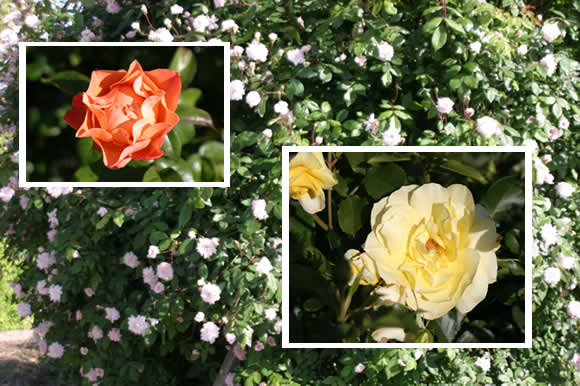 Starting in March we eagerly look forward to the first red ripe strawberry. Strawberries keep producing until late October or early November. After June's ollalieberry harvest, the Japanese plums and Blenheim apricots have their intense but delectable 2-3 week debut; by then the blackberries and raspberries will have had enough time to mature, and will compliment the continuous everbearing strawberries; in the Fall, apples and pears take center stage; and the last to close off the season is the often overlooked and less known of the Rose Family members, the fragrant yellow Quince. 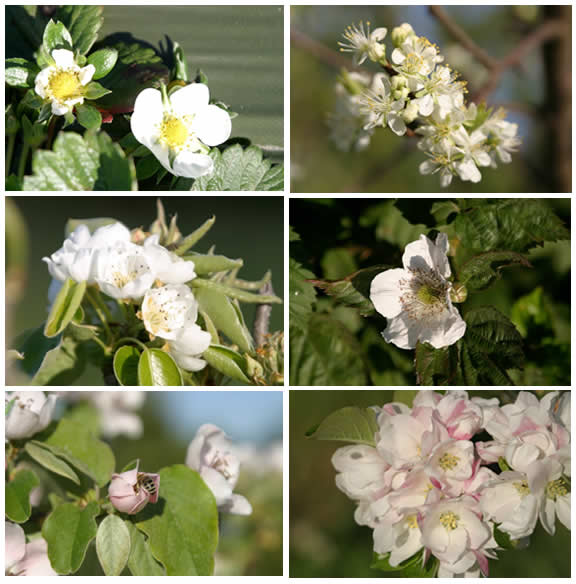 (clockwise from top left: strawberry, plum, blackberry, apple, quince, pear) Looks are DeceivingAfter an unusual couple of downpours on Mothers Day, the afternoon sun came out just in time to enjoy a stroll through the fields with family and friends. As we walked past a block of mature mei qing choi, which I knew had suffered considerable flea beetle damage, I showed the holey leaves to our friend and long-time CSA member Sara Lyon (one of the first, back when we started our CSA 15 years ago with less than 20 members), wondering aloud whether to harvest them for this week's shares. She said she doesn't pay attention to the cosmetic appearance anymore, and remembered a newsletter article I wrote years ago which described the increased nutritional benefit of vegetables that have endured damage by nibbling insects. I found the newsletter (November 2003) and here is what I wrote: "Believe it or not, thanks to slugs, bugs and insects we actually grow healthier food. Most of you have seen all sorts of pecks and holes in your veggies, and the excuse has always been 'oh, this means it's organic.' A peck, a hole, or a little blemish has always served as 'certification' to our customers that we are striking a balance with the creepy crawlies in the field. Recently though, curious ivory tower scientists are proving what organic farmers have said all along - that looks are deceiving, and it's what's inside that's good for you! According to studies by a food scientist at UC Davis, organic produce boasts up to 50% more antioxidants than conventionally grown produce. Turns out plants fight off insects and disease by naturally producing phytochemicals (plant chemicals) such as flavanoids to protect themselves - a process similar to the human immune system. What this means is that conventional crops which are doused with pesticides are not only laced with toxic chemicals, but also lack the antioxidants, because there is no pest pressure to induce the response!" 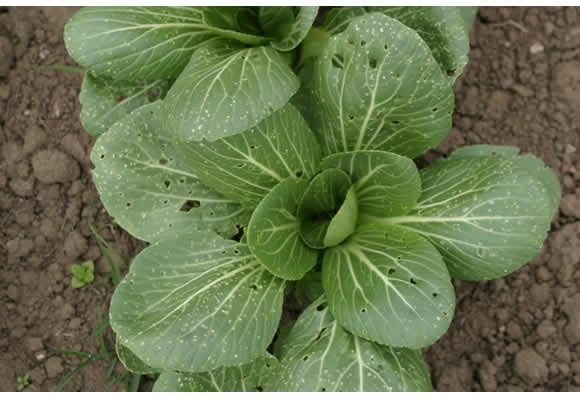 I don't expect a sudden spike in demand for "holey" mei qing choi or arugula (the two crops which typically show the most impressive battle marks of a successful fight against flea beetles), but you may consider cooking them in such a way that their cosmetic appearance is hidden while still getting the nutritional benefit.
- Tom |
Ducklings!
~~~~~~~~~~~~~~~~~~~~~~~~~~~~~~~~~~~~~~~~~~~~~~~~ I (Debbie) went for a walk on the farm last week, to go visit the duck nest Molly and company told me about, see if I could find it. There have been a pair of mallard ducks who've scoped out the pond behind Tom and Constance's house for a few seasons now, but as far as we know, this was the first time they've built a nest. Molly discovered eggs in the nest the week before last, so I was eager to see them. Lo and behold, when I found the nest, the mama was setting on it! Not only that, but I saw a rustling in the grass beside her... and to my amazement, it was baby ducklings! What was really incredible though was how the mama did not move an iota. She was still as a stone, even though I was close enough to reach out and touch her. Within moments, the babies quickly followed mama's example, and, motionless as they were, they were perfectly camouflaged. The only movement I could see was the little one closing its eye, then opening it again. The yellow and brown and black of their down was nearly invisible in the light and shadow of the yellow-brown grasses. Isn't nature amazing? 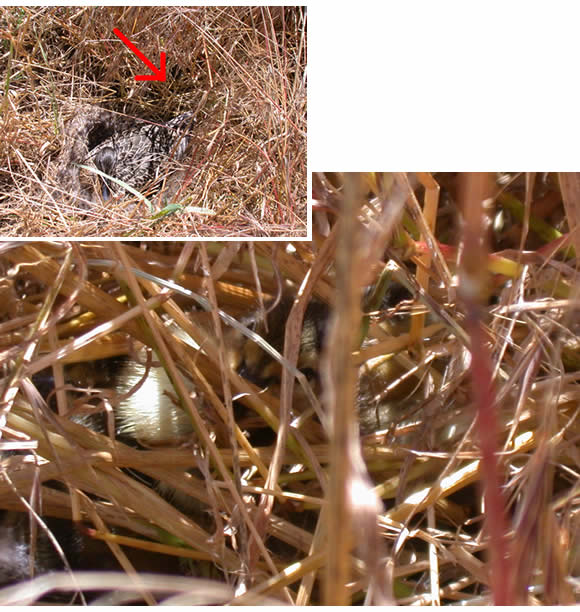 |
Please don't tear the box flaps!
~~~~~~~~~~~~~~~~~~~~~~~~~~~~~~~~~~~~~~~~~~~~~~~~ Tom says many of our waxed boxes are coming back from the pick-up sites with torn flaps, rendering them useless. We collect and re-use them each week, and they have the potential of lasting the season as long as the flaps are not torn. PLEASE take the time to observe how they open: look for the creases in the flaps. Wherever there is a crease, squeeze to fold that flap along the crease and it will slip out of its tab. This holds true for both the top and bottom of the box. After removing your veggies, turn the box over and squeeze the flaps to 'unlatch', then fold flat and stack neatly with the other boxes. And if you know how to do this and happen to notice another member struggling with it, please offer to help by showing them the technique. Once you understand it, it is very easy!  |
"Extra Fruit" or "Fruit Bounty"? A refresher course
~~~~~~~~~~~~~~~~~~~~~~~~~~~~~~~~~~~~~~~~~~~~~~~~ Do you have a fruit option? If so, do you know which one you have?Many new folks are so excited that a fruit option is available to them when they sign up that they don't notice that we have two different fruit options. I received many emails and phone calls last week (the first week of our "Extra Fruit" option), from people who thought they were being unfairly deprived of their rightful fruit (they were signed up for the "Bounty", which hadn't started yet). [But THANKS to one and all for sticking to my rule of "only take what's listed next to your name"! There were very few shortages as a result :-)] KNOW YOUR FRUIT OPTIONPlease refer to your signup confirmation if you don't remember which fruit option you selected. Here are the differences: Extra Fruit is 29 weeks of additional fruit. It started last week and will be every week from now through the end of the season. Fruit "Bounty" is 15 floating weeks of additional fruit. This means it could be 'on' one week, and 'off' the next. We cannot tell you when you sign up which weeks during the season you will receive your additional fruit, however we promise you that by the end of the season, you will have received your allocated share of "Bounty". We announce "bounty" weeks in the newsletter, at the bottom of the "What's in the box" section (after what's in the "Extra Fruit" option). WHEN WE HAVE DIFFERENT KINDS OF FRUIT THE SAME WEEKRight now, the only fruit that's ripe is strawberries. But if you read Tom's blurb above, you'll see that there are many different kinds that come down the pike over the course of the season. When we have different kinds of fruit, Tom has to do the calculation of who will get what based on what he anticipates coming out of the fields. Sometimes the fruit options will receive different things. Sometimes even the same fruit option on a Wednesday will get different fruit than on a Thursday. It is always a juggling act. That's why we ask you to ALWAYS go by what's on the checklist, not by what you remember from the newsletter. We carefully allocate and distribute fruit to the pick-up sites based on those calculations, and sometimes what actually comes out of the fields will be different than what Tom anticipated, and so we have to make last-minute adjustments. The checklist will always spell out next to your name exactly how much of each kind of fruit to take. As long as you follow the checklist, you will get your proper fruit, and so will everyone else!Thanks! Debbie PS - if you want to read more about the differences between our fruit options, please go to the "Become a Member" page on our website, and scroll down to the "Signup Checklist" section. You'll find the discussion on our two fruit options there. In exhaustive detail, if you click on "Reveal/Hide the details" ;-) |
One more thing about fruit...
~~~~~~~~~~~~~~~~~~~~~~~~~~~~~~~~~~~~~~~~~~~~~~~~
If you ARE getting a fruit option, please remember to bring containers with you for taking your fruit home in. Do not take the cardboard boxes the berries come in (called "flats"). I know this is tempting, because some of you are getting many baskets a week, but we re-use those boxes too, and they are not free.
Thanks again!
|
Paid High School Internships at Veggielution in San Jose
~~~~~~~~~~~~~~~~~~~~~~~~~~~~~~~~~~~~~~~~~~~~~~~~  Hey, do you know a high schooler looking for something more exciting than facebooking to do this summer? And do they need some money? Or are YOU a broke teenager looking for something exciting to do this summer? Well, lucky for you, Veggielution has just the thing for you! They are offering PAID summer positions to high schoolers. Their summer program is a 6 week position, in which high schoolers will work Tuesday through Saturday. They will come out to Veggielution for about 20 hours a week and earn a $600 stipend. Time on the farm will include lots of hard farm work, but also lots of fun, a few field trips and an opportunity to learn about health issues, the food system, sustainable agriculture and how to cook! Of course, let us not forget the biggest bonus: hanging out with awesome Veggielution youth program coordinators Jessie Nichols and Sally Neas. Applications materials, as well as more information about the program, can be found on their website. Please feel free to email Veggielution with any questions ( SallyN@veggielution.org or JessieN@veggielution.org). Applications are due May 15th, so get them done quickly! |
Organic Watchdog Asks USDA to End Labeling Abuses
~~~~~~~~~~~~~~~~~~~~~~~~~~~~~~~~~~~~~~~~~~~~~~~~ This article is courtesy of the Cornucopia Institute, a Wisconsin-based nonprofit farm policy research
group, dedicated to the
fight for economic justice for the family-scale farming community.
Their Organic Integrity
Project acts as a corporate and governmental watchdog assuring that
no compromises to the credibility of organic farming methods and the
food it
produces are made in the pursuit of profit.Prominent Brands
Using "Organic" in Their Name When Products
Don't Qualify While
the organic label is the gold standard of eco-labels on food packages, one
major loophole in the federal organic standards remains - which an organic
industry watchdog is asking the USDA to close. Companies are tightly
regulated in terms of their use of the word "organic" on food packaging, but
some businesses are deceiving customers by using the words "Organic" or
"Organics" in their company name on food that does not legally qualify as
organic. "Companies are getting away with using the word 'organic' in
their company name, listed prominently on food packages, even if the product
they're selling isn't certified organic," explains Charlotte Vallaeys, Farm and
Food Policy Analyst with The Cornucopia Institute. "These companies are
taking advantage of the good name and reputation of organics, without going the
extra mile to actually source all organic ingredients in their products." The Cornucopia Institute, a Wisconsin-based farm policy
research group, has sent a formal legal complaint to the USDA's National Organic Program, and a second similar complaint to the Federal Trade Commission, highlighting labeling improprieties with three
food brands; Oskri Organics, Organic Bistro and Newman's Own Organics. These companies sell products that do not qualify to bear the "USDA Organic"
seal, yet may appear organic to consumers based on the prominence of the word
'Organic' in their brand name. Oskri Organics sells a variety of foods, including fruit
preserves, nutrition bars and tahini (sesame butter). Some of their
products, however, contain no certified organic ingredients. These Oskri
Organics products are therefore no different from conventional foods, yet many
consumers are presumably being unethically led to believe they are organic
based on the company name, displayed on product packaging. Organic Bistro sells frozen entrees made with organic
vegetables, but uses non-organic chicken and turkey. "There is
certainly no shortage of organic chicken or organic turkey, which are,
obviously, more expensive than conventional meats," said Mark Kastel,
Cornucopia's codirector. "By using conventional ingredients to cut
costs, yet displaying the word "Organic" so prominently on their packages,
Organic Bistro is unfairly competing with truly organic companies that commit
to sourcing organic meat." Newman's Own Organics sells some certified organic products
and some that only qualify for the "made with organic" label (70% organic
content), yet uses the term "Organics" in their name-on all food
packages. "Consumers
should be able to trust that any food package with the word "Organic" displayed
prominently is truly certified organic, contains predominantly organic
ingredients, and meets the letter and spirit of the law," Kastel added. To view images of an Oskri Organic's product label, click
here: http://www.cornucopia.org/USDA/OskriLabel3.jpghttp://www.cornucopia.org/USDA/OskriLabel1.jpghttp://www.cornucopia.org/USDA/OskriLabel2.jpg To view a screenshot of Newman's Own Organics webpage, click
here: http://www.cornucopia.org/USDA/NewmansScreenshot.pdf |
LEF Discovery Program Update
~~~~~~~~~~~~~~~~~~~~~~~~~~~~~~~~~~~~~~~~~~~~~~~~ from Jessica Ridgeway This week I am working hard on our upcoming fundraiser, so
that is what you will get to hear a bit about here. On September 25th, we will host our second annual Farm to Fork fundraiser dinner. We will be serving hors
d'oeuvres in the field where they were grown, paired with local wine, and
prepared with love by local chefs and artisans. We already have some amazing people and businesses
supporting us including: Happy
Girl Kitchen; Companion Bakers; Rebecca Mastoris, Karen Harelson, and Nancy Birang;
and Storrs Winery. At this stage I am garnering support in the form of
volunteers, sponsorships and donors. If you would like to help, here are the things you could do right away: 1) Let me
know of any connections you have to California Wineries or Brewers 2) Sell
tickets to the event, or purchase yours. 3) Volunteer
to Table at Weekend Farmer Markets (Westside SC, Scotts Valley, and Los
Gatos). 4) Donate
and item(s) for the Silent Auction Please contact me if you are interested in helping in any of
these ways or have an idea of your own. Jessica Ridgeway lefeducation@baymoon.com831-728-2032
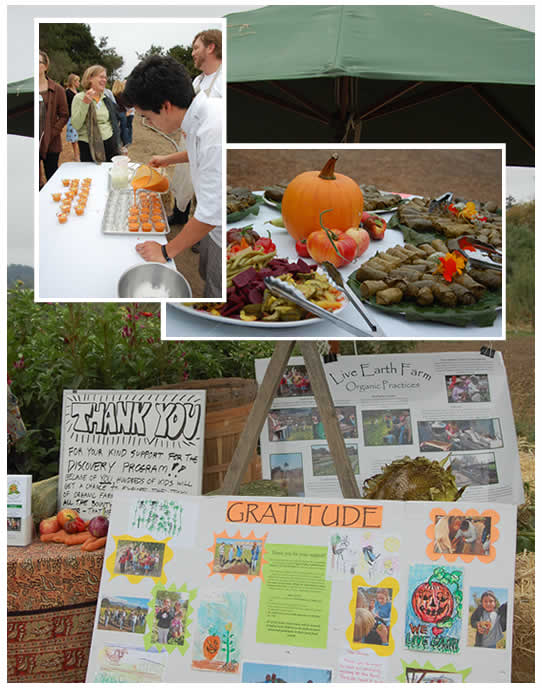 Last year's dinner was a big success! |
Notes from Debbie's Kitchen~~~~~~~~~~~~~~~~~~~~~~~~~~~~~~~~~~~~~~~~~~~~~~~~ Click here to go to the recipe database.I updated last week's Grilled Pizza recipe a little (the version in the recipe database) after getting word from Mary about something I hadn't gotten quite right (timing on the second cooking step, after toppings have been added). So if you go to make it, please refer to the web version rather than the one in your email inbox. Meanwhile, this week, I want to talk to you about greens prep and storage. It has come up a couple of times in the last week in discussion with members, so I think the time to cover this is now. I'm also going to cover strawberry prep and storage, since strawberries are starting to come in in force. Plus a bit more about radishes, and whatever else I have time to include ;-) - DebbieOh, before I forget: we're getting fresh young (green) onions for the first time this week. Although bigger than scallions, you can still mince up and use the light green part of the stem like you would scallions (or simply chop up the white and light green part and cook wherever you would use dry-storage onions). Greens prep and storageMake no doubt about it: if you stick a plastic bag full of wet greens into your refrigerator, they won't keep long. Very quickly, they'll start rotting. Especially if they're as delicate and tender as the baby lettuces. Yet this is what many folks do when they get their veggies home from their pickup sites. If you prepare your leafy greens properly, however, they will easily keep for the week (until you are re-supplied, in other words!). I know sometimes you don't have time to deal with them the day you pick up, so if not, hopefully within a day or so you can pull them out and 'prep' them, as I'm going to describe below, without them being much the worse for wear. If your time is limited, select the most delicate greens to prep, like the bagged baby lettuces. The tenderer the leaf, the more delicate its constitution, and the more susceptible it is to rot. Here are the types of greens I will prep in this fashion: - baby lettuces - arugula - tatsoi - mizuna - mustard greens - spinach - radish greens (yes, you can eat them! they make a good cooking green) And the tools I use: - a big bowl or a sink - a salad spinner (if you don't have one, I have a tip) - cotton floursack towels (or any towel will do) - clean, dry plastic bags (I've used Evert-fresh bags to good success; you can find them in catalogers such as Real Goods, but they are not a requirement) The larger and hardier bunched greens such as kale, collards, chard, and even mei qing choi I do a little differently (they're eaiser). I'll cover them briefly below, but let's get back to the delicate leafies: In a basin or sink, put each batch of greens (I do them one at a time) and add enough water so you can swish them around reasonably freely. Swish them around good, and then pick them out, in handfuls or individually if you like, inspect them for dirt, pinch off any root ends or broken stems (in the case of spinach, I pinch off most of the stem, saving the leaves), and remove any weeds or leaves which are yellowed, transferring the select greens into your salad spinner. 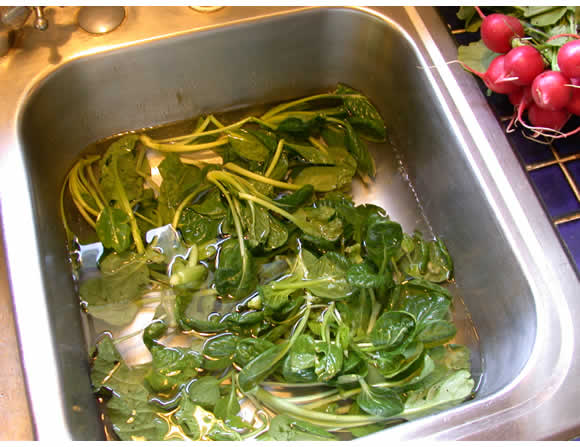 Sometimes you will find bonus goodies in your greens! In last week's tatsoi, I had some red mustard greens. And a weed or two. 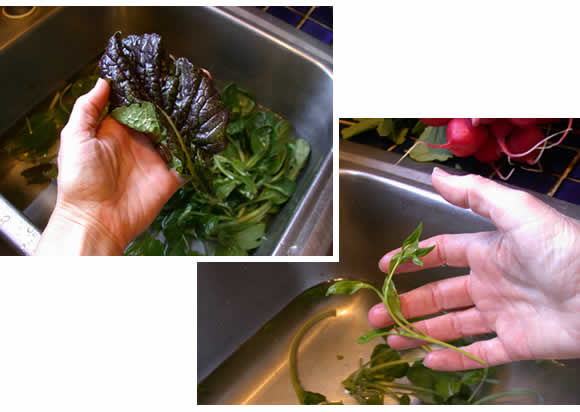 Spin the greens well (spin, pour out the water, spin again, and repeat, until you're not getting more water in the bottom of the spinner). Then spread them out on a clean towel out of the sun and allow to air dry while you prep your next batch of greens. A few drops of moisture here and there are not the end of the world, but they should be 95% or better dry before you bag them. 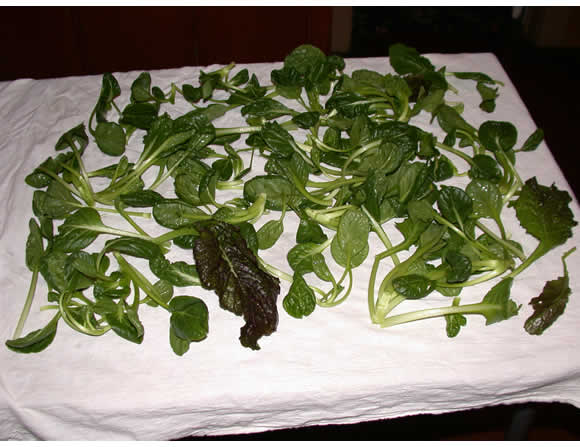 Transfer greens to a plastic bag, gently squeeze or suck out the air (like the reverse of blowing up a balloon), and tie with a twisty-tie. These are now good to go! You will now have a bag of fabulous fresh greens all washed and ready to go, which you can grab and use, without worry of dirt or bugs or weeds or rot. Shortcut: if you don't want to wait for your greens to dry, you can roll the greens up, towel and all, and put them into a plastic bag overnight. By the next day, the towel will have absorbed the moisture and you can decant them back into the bag, removing the towel. (Don't store them in the towel too many days this way, as they'll go limp. Still good to cook with, but if you wanted a fresh salad, you'd have to perk them up in water, spin and dry again before using.) No-salad-spinner tip: I learned this from a cookbook called "Soup and Bread" by Crescent Dragonwagon. Put your washed greens into an old pillowcase and (go outside to do this!), swing the bag around wildly over your head or around in the air like a lasso, and the water will 'spin' out. Storing the hardier bunched greens (kale, collards, chard, mei qing choi) As I said, these are easier. I typically don't wash them until I'm ready to use them (and sometimes not even then, if upon inspection there are no signs of dirt or aphids!). But I do let them air dry on a towel as I'm sorting through my bag of goodies and prepping other stuff before bagging and putting into the fridge. When mostly dry, then put them into a bag, squeeze the air out, etc. and refrigerate. You can use the same shortcut for these as the other greens, i.e. if you're in a hurry and the bunched greens are wet, wrap them in a towel and stick them in a bag (or your crisper drawer) overnight to absorb the extra moisture, then transfer them to a bag the following day. Strawberry storage tips(repurposed from a 2003 newsletter entry) Different weather conditions will make a huge difference in the
storability
of strawberries. In the cooler weather, they can be red, ripe
and firm,
and store well for a week. But in the summer heat they can
become far
more fragile, requiring immediate processing or they can go bad
on you.
I highly recommend processing them in some way as soon as you
get them
home. Your best options for fragile-berry-syndrome (I made that
up!) are
to freeze them, make jam or pie, or cut them up, sprinkle with
sugar,
stir, cover and refrigerate. They will still need to be consumed
within
a few days though. Here is how I 'process' my berries: I empty them out onto a cutting board or table top (used to put them on paper towels, but have tried to cut them out of my life)
and then carefully re-pack my baskets. Do
not wash them at this stage - only wash them when you're
ready
to
use them! Remember: wet berries rot quickly! Once spread out, I look over the berries
and re-pack
them, starting with the least-ripe ones first, working my way up to the more ripe
ones. This technique allows you to weed out any blemished
berries
which are perfectly fine if you cut them up and eat them right
away, but
which will take down adjacent berries in a basket if left
unchecked. Cover
each basket with a piece of waxed paper big enough to cover the
sides
and secure with a rubber band (don't use plastic wrap - the
berries
need to breathe). Place covered baskets in your
fridge arranged so that the ripest baskets of berries are to the front, leaving the less ripe berries towards the back because they will last
longer.
And I'd swear that they continue to ripen, even in the fridge,
so this
is an added bonus for the 'less ripe ones!' To freeze berries: remove strawberry tops and lay
whole berries on a sheet
of waxed paper on a cookie sheet. Freeze solid, then remove
berries to
a ziploc bag and return to the freezer. They will last months
this way.
I don't generally wash them before I do this (one of the
'bennies' of
eating organic!), but if you prefer to, be sure to blot them dry
before
you freeze them. Lastly, since I know members are always looking for ways to use radishes, here is another wonderful radish story from the New York Times: this time, on roasted radishes! Some really yummy ideas! But rather than copy and paste it here, I'm just going to give you the link. It's worth clicking on, if only for the picture!
Roasted Radishes - so who knew?http://www.nytimes.com/2010/05/12/dining/12appe.html?partner=rss&emc=rss |
|
2010 CALENDAR
~~~~~~~~~~~~~~~~~~~~~~~~~~~~~~~~~~~~~~~~~~~~~~~~
Visit our website's calendar page for more details, including photos and videos of past events. This is a great way to get the flavor of what it is like visiting the farm!
Live Earth Farm Discovery Program for WEE ONES
3rd Tuesday of every month, 10:30am - Noon
(free for children 0 - 3 yrs; $10 - $15 per adult)
 Mothers, fathers, grandparents, caretakers of any kind... bring the babe in your arms to experience the diversity of our beautiful organic farm here in Watsonville. We will use our five senses to get to know the natural world around us. The farm is home to over 50 different fruits and vegetables, chicks, chickens, goats, piglets, and the many wild members of the Pajaro watershed. Mothers, fathers, grandparents, caretakers of any kind... bring the babe in your arms to experience the diversity of our beautiful organic farm here in Watsonville. We will use our five senses to get to know the natural world around us. The farm is home to over 50 different fruits and vegetables, chicks, chickens, goats, piglets, and the many wild members of the Pajaro watershed.
For more information, contact Jessica at the LEFDP office: (831) 728-2032 or email her at lefeducation@baymoon.com.

Happy Girl Kitchen's 2010 Workshop Schedule at LEF
(all workshops are from 10am to 3pm and include an organic lunch, as well as take-home items from what is made that day!)
March 6 (Saturday) - Fermentation (sauerkraut, kimchee and kombucha)
April 10 (Saturday) - Cheese and kefir
June 6 (Sunday) - Cherries and spring berries
July 10 (Saturday) - Apricots, strawberries and blackberries
September 12 (Sunday) - Heirloom tomatoes
October 2 (Saturday) - Pickles
Contact Jordan if you have any questions
jordan@happygirlkitchen.com
http://www.happygirlkitchen.com
Community Farm Days Schedule
(All Community Farm Days are Saturdays unless otherwise noted.)
March 20 - Sheep to Shawl
May 29 - Three sisters planting in the field! Help sow pumpkins, corn, and beans
June 19 - Summer Solstice Celebration and Strawberry U-pick
July 3 - Apricot and Strawberry U-pick
July 12 thru 16 - Summer Celebration Art on the Farm Day Camp!
Aug 28 - Totally tomatoes. From farm to fork, cooking with tomatoes and making farm-fresh cheese. Also U-pick raspberry and tomato day!
Sept 25 - LEFDP Second Annual Fundraiser
Oct 23 - Harvest Celebration and Apple U-pick
|
|